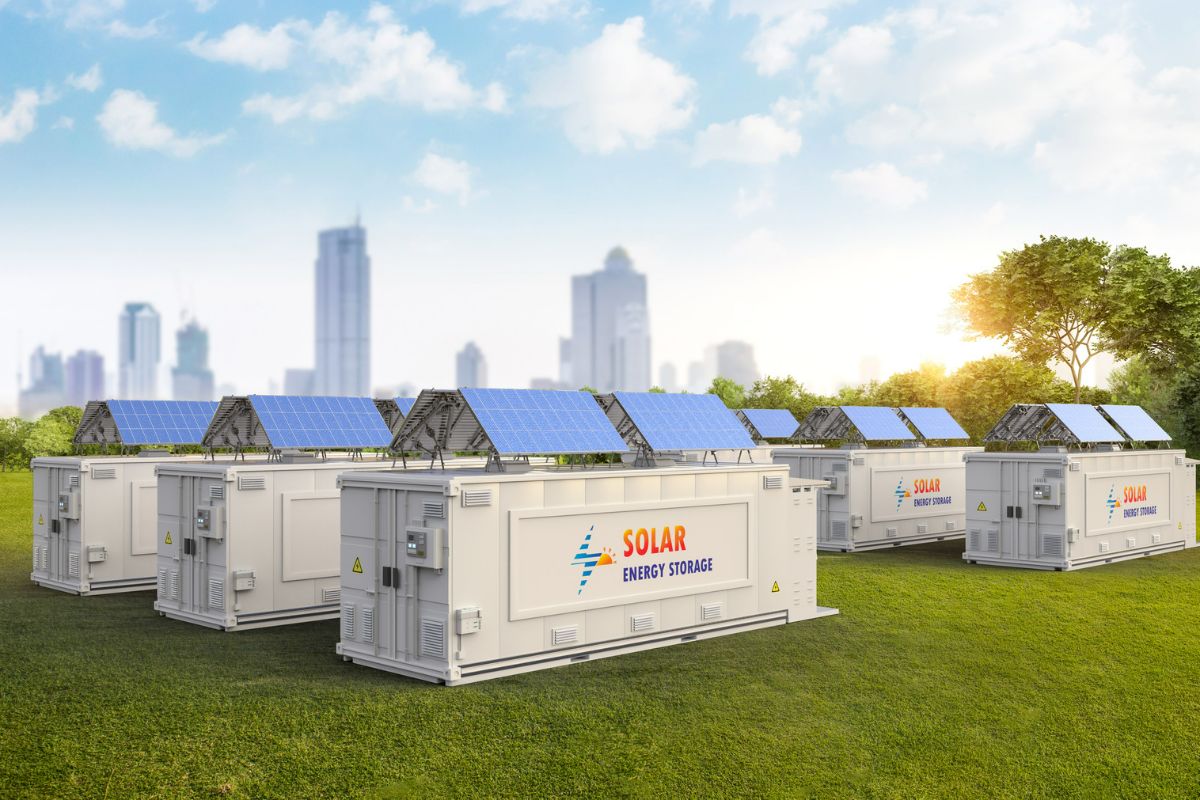Community Energy Storage – The Future Energy?
The community energy storage (CES) concept entails a utility-owned CES situated at the borderline of the utility distribution system, easily accessible to end-users. Utility-owned CES systems comprise multiple battery storage units connected to low-level transformers for small businesses and homes.
Community storage helps integrate renewable energy resources into the grid by addressing notable regeneration challenges. Solar energy storage systems have become more popular due to the increasing interest in renewable energy, self-consumption, and energy independence.
CES has become more appealing in recent years due to the growing demand for clean energy. Moreover, the rising electricity cost aroused the attention of stakeholders and investors who have become increasingly interested in electricity storage.
This article focuses on the future, benefits, and usage of community energy storage. It also addresses choosing the best systems for your home or business.
What Is Community Energy Storage?
Community energy storage is an emerging advanced Smart grid technology. It is often situated at the perimeter of distribution to ease the impact of intermittent distributed energy resources (DERs) and integrate the power source with the broader cellular grid.
This technology may encompass several storage technologies, including EVs and batteries. It may also include thermal storage systems such as electric space heaters, water heaters, and ice storage. Most residential areas and homes have resorted to energy storage systems to reduce electricity bill payments and increase self-consumption and grid independence.
A utility-owned or community-operated solar project may be part of CES. One may consider CES as backup power for a group of residential buildings as it stores energy in batteries and supplies active power while discharging. It complements the community solar by improving the quality of renewable generation supplies to the power grid and increasing demand response.
How Does Community Energy Storage Work?
The working principle of CES systems depends on the usage context. Some utility companies now explore the potential of integrated energy storage solutions into their grids.
The CES system typically comprises a collection of two or more batteries directly connected to a low-voltage utility distribution grid that serves commercial buildings and homes.
Here are the main components of the CES system.
- Battery.
- Four-quadrant inverter (in-grid inverter panel).
- A measurement or control system (in-meter and breaker panel). The control system comprises the battery management system and inverter monitoring.
The battery units follow three operational phases. These include the discharge, standby, and charge phases. The system may discharge fully active, inductive, or reactive power according to the four-quadrant inverter capacity.
CES systems perform the following tasks:
- Peak shaving
- Energy conservation
- Optimization engine.
These functions help the system to discharge during partially peak real-time intervals. The initial concept of CES used high and medium-voltage substations consisting of batteries to provide regional control at the transformer level.
However, the new CES types consist of substation batteries that can provide voltage regulations. They do so through four quadrant inverters without needing on-load tap-changers (OLTCs).
In summary, CES systems store energy during the charging process, which remains on standby, pending when active or reactive demands arise. The discharge (supply) time in most CES ranges between 1 and 3 hours per operation cycle.
Advantages of Community Energy Storage
CES is among the most advanced smart grid technologies offering many benefits to power distribution grids and renewable energy solutions. It provides stability, reliability, and control, improving the power quality distributed to a community or businesses while reducing carbon emissions and its environmental impacts.
CES solves the proximity challenges by eliminating the power stability and quality constraints seen when no utility substation is nearby.
Community storage could also offer environmental and social benefits such as sustainability, community engagement, energy security, a sense of community, and democracy. It can enhance the local community’s transformative roles toward a clean, sustainable, decentralized, inclusive, and decarbonized energy system.
Community storage is emerging as a decentralized solution in the evolving energy landscape, aiming to confront the challenges in the present energy systems. It increases the self-consumption of local generation, congestion management, and voltage regulation, encouraging grid relief by peak shaving power production and demand response. In addition, it provided relief from using fossil fuels.
More so, CES increases short and long-term decoupling of power supply and demand while saving costs through grid reinforcement delays. However, the existing regulatory regimes must change to accommodate these developments for improved governance and market structure.
It can also provide ancillary services needed to provide voltage regulation, stabilize the electrical grid and offer utility benefits, which include cost savings and grid services. These ancillary services include energy balance, system protection, voltage and frequency regulation, etcetera.
What Storage Options Does Ces Use?
The energy storage options include battery, thermal, pumped hydro, hydrogen, and mechanical systems. But one can pair these technologies with software that controls energy charge and discharge.
Battery Storage
Most community storage systems consist of batteries that store and deliver energy through electrochemical reactions. They are of various kinds, including lithium-ion, flow, sodium, lead acid, etcetera. Your choice of battery largely depends on your power and duration requirements.
However, lithium-ion batteries are the most used. They have a range of applications, from powering smaller residential systems to larger ones. Also, they can store multiple megawatt hours and support the entire electric grid.
Lithium-ion battery systems house multiple batteries on a rack with monitoring and management units, making them suitable for storage systems like CES. Given the large amount of energy they store, lithium-ion battery storage systems have little to no carbon footprint.
People implement battery storage at a community scale for solar integration, load stabilization, and as backup power.
Pumped Hydro Systems
Energy storage with pumped hydro systems consists of large water reservoirs. The system propels water to cycle between two tanks (reservoirs) at different levels. The system stores energy when the water enters the upper tank. The stored energy then discharges when the system releases water to the lower reservoir.
Hydrogen
Hydrogen as a kind of energy storage is still an emerging technology. It involves the conversion of electricity from one form to another through electrolysis. You can store the energy in tanks for re-electrification or supply to electric vehicles or residential houses.
The Growth of Community Energy Storage
Energy storage usage at the local level is evolving due to its declining cost and increasing demand for flexibility. Community storage could contribute meaningfully towards energy transition, accommodating the needs of residents.
However, integrating CES into the existing centralized energy systems calls for socio-technical innovation. The current system is undergoing rapid institutional and technological changes at the local and central levels. Therefore, the energy landscape is changing from centralized generation, transmission, and distribution to a more decentralized system.
The ongoing transformation means well for the CES system due to the need for greater engagement of residential areas. The supply and demand mismatch is among the roadblocks to the shift towards a low-carbon system. The concerns increase due to higher intermittent generation via distributed energy resources (DERs) like solar and wind.
The system must adopt new approaches to balance energy storage with the involvement of local communities to achieve sustainability. Luckily, CES, a bona fide solution to these issues, is gaining more traction by the day.
While CES has its challenges, its success requires timely satisfaction of the needs and objectives of local energy communities. CES technologies can shape future society and community energy needs, influencing their development and innovation.
Estimated Cost of Home Energy Storage
Solar power systems have become the most used in recent years. The leap is due to the increasing demand for sustainability and more people looking to go off-grid and become energy-independent.
That resulted in an increased dilemma over the suitable battery system for households as costs vary with the storage capacity. Are you looking to implement an energy storage system for your home? You’re not alone in this. Here are the estimated costs based on system sizes.
On average, household batteries cost around $4,000 for a 4kWh capacity to $15,000 and above for a sizeable 12kWh battery. It is worth noting that the costs depend on the type of battery and inverter, installation location, and backup power requirements.
An average 3-bedroom house could use about 20kWh of electricity in a day. But some usages occur during the day and could be powered directly with solar. That said, a moderately sized 10kWh battery would be enough to cover energy requirements in the evening hours and overnight.
In Australia, a battery system may cost around $1,000 per kWh, but in the US, the same could cost nearly $700. For instance, it will cost about $15,000 to install Tesla Powerwall 2 with a capacity of 13.5kWh. But a 9.8kWh LG RESU battery will cost around $6,000 with the additional costs of a compatible hybrid inverter and installation.
Switchboard upgrades may attract additional costs, particularly if dedicated circuits require backup during a blackout. In summary, the cost of purchasing and installing battery systems depend on the type, storage capacity, location, and power requirement.
How to Choose the Best Energy Storage Option?
There are several energy storage options, each with unique benefits and drawbacks, which users should consider before implementation.
The primary factors to consider before choosing an energy storage option include:
- Charge
- Discharge profiles
- Storage capacity
- Energy density
- Potential scalability
- Installation cost
- Life cycle
- Maintenance requirements
Before choosing energy storage, you must determine your energy needs based on your daily usage, home size, and appliances. You can estimate your energy usage by checking your monthly electricity bills. It is also advisable to consider future energy needs, as they may increase over time.
The rapid cost declines of Lithium-ion battery makes battery storage the best and most popular option for small-scale residential and EV applications lately. Lithium-ion batteries may be more expensive but offer several benefits than lead-acid types. They are more efficient and can store more energy for long periods.
However, on a larger scale and longer duration, you may consider thermal, pumped hydro, and in the future, hydrogen. But considering the growing demand for sustainable energy, the integration of renewables such as solar and digitalization offer improved value and economics than hydro.
Frequently Asked Questions
What Are the Three Main Types of Energy Storage?
There are several energy storage systems, but the three main types include thermal, battery, and hydro.
What Is the Most Efficient Energy Storage?
Lithium-ion batteries are the most efficient energy storage options. Lithium-ion batteries may have up to 90% efficiency. However, their efficiency may decline as the battery begins to degrade, which depends on the intensity of use. A virtual power plant may utilize lithium-ion batteries for storage.
How Much Does Home Energy Storage Cost?
Some residential lithium-ion battery installations cost between $7,000 and $14,000. However, the actual price of home energy storage depends on the manufacturer, chemistry, number of batteries, labor cost, and necessary upgrades.
What Is a Community Energy Project?
It refers to the delivery of community-led renewables, energy demand reduction, and supply projects wholly or partly owned or controlled by communities. Communities often manage these projects by collaborating with commercial or public sector partners.
Summary
Although community energy storage is still an emerging technology, it holds a powerful concept that has revolutionized renewable energy generation. That concept has evolved, to a large extent, over the years due to its benefits and growing climate change awareness.
These benefits include the potential cost savings with standardized, flexible, modular utility-owned solutions while deferring transmission and distribution upgrades.
But people are yet to understand the potential revenue stream in CES. With its ability to enhance the value and effectiveness of the grid, CES could become a standard solution for the energy future.


